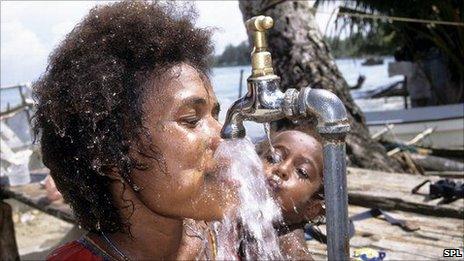'Super sand' to help clean up dirty drinking water
- Published

Contaminated water can be cleaned much more effectively using a novel, cheap material, say researchers.
Dubbed "super sand", it could become a low-cost way to purify water in the developing world.
The technology involves coating grains of sand in an oxide of a widely available material called graphite - commonly used as lead in pencils.
The team describes the work in the American Chemical Society journal Applied Materials and Interfaces.
In many countries around the world, access to clean drinking water and sanitation facilities is still limited.
The World Health Organization states that "just 60% of the population in Sub-Saharan African and 50% of the population in Oceania [islands in the tropical Pacific Ocean] use improved sources of drinking-water."
The graphite-coated sand grains might be a solution - especially as people have already used sand to purify water since ancient times.
Coating the sand
But with ordinary sand, filtering techniques can be tricky.
Wei Gao from Rice university in Texas, US, told BBC News that regular coarse sand was a lot less effective than fine sand when water was contaminated with pathogens, organic contaminants and heavy metal ions.
While fine sand is slightly better, water drains through it very slowly.
"Our product combines coarse sand with functional carbon material that could offer higher retention for those pollutants, and at the same time gives good throughput," explained the researcher.
She said that the technique the team has developed to make the sand involves dispersing graphite oxide into water and mixing it with regular sand.
"We then heat the whole mixture up to 105C for a couple of hours to evaporate the water, and use the final product - 'coated sand' - to purify polluted water."
Cost-efficient
The lead scientist of the study, Professor Pulickel Ajayan, said it was possible to modify the graphite oxide in order to make it more selective and sensitive to certain pollutants - such as organic contaminants or specific metals in dirty water.
Another team member, Dr Mainak Majumder from Monash University in Melbourne, Australia, said it had another advantage - it was cheap.
"This material demonstrates comparable performance to some commercially available activated carbon materials," he said.
"But given that this can be synthesized using room temperature processes and also from cheap graphite sources, it is likely to be cost-efficient."
He pointed out that in Australia many mining companies extract graphite and they produce a lot of graphite-rich waste.
"This waste can be harnessed for water purification," he said.
- Published9 May 2011
- Published5 April 2011
- Published5 June 2011